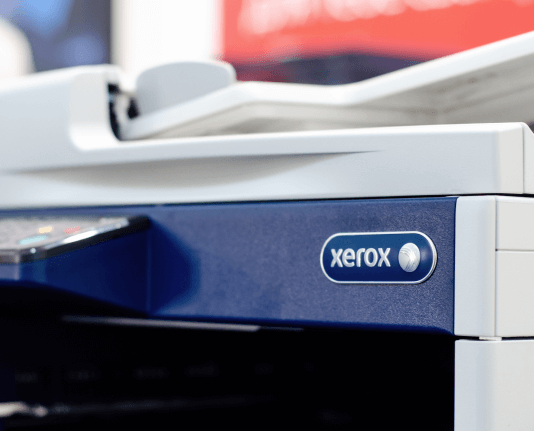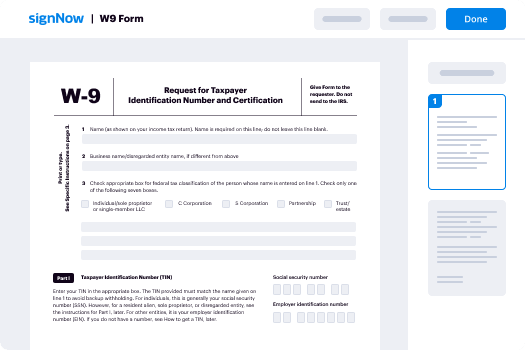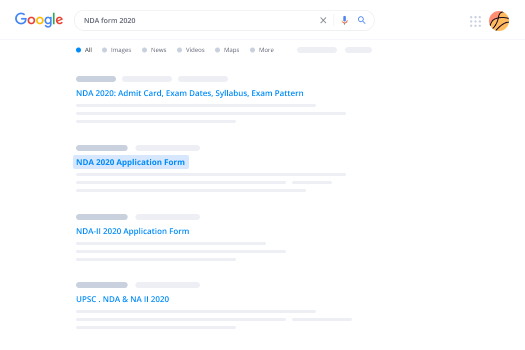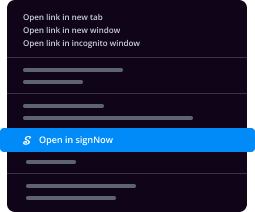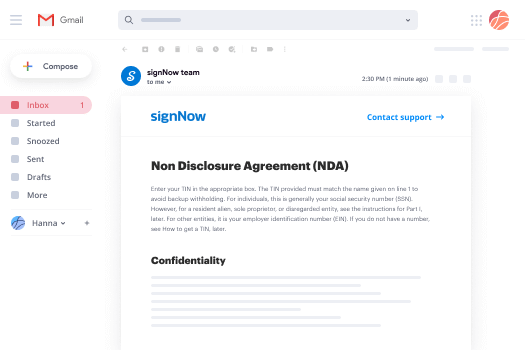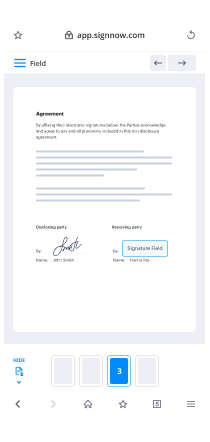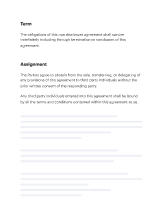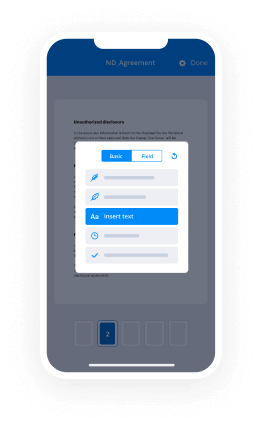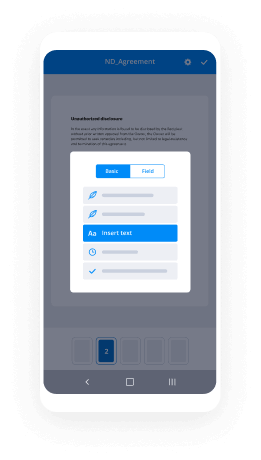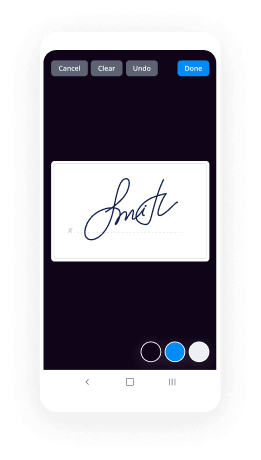Fax Sign Form iPad
Make the most out of your eSignature workflows with airSlate SignNow
Extensive suite of eSignature tools
Robust integration and API capabilities
Advanced security and compliance
Various collaboration tools
Enjoyable and stress-free signing experience
Extensive support
Keep your eSignature workflows on track
Our user reviews speak for themselves






How to send a fax from iPad
If you're seeking an effective method to send a fax from your iPad, airSlate SignNow provides a smooth solution that merges convenience with utility. With its intuitive interface and powerful features, you can effortlessly transmit faxes without difficulty. This guide will lead you through the procedures necessary to successfully send your documents from your iPad using airSlate SignNow.
How to send a fax from iPad using airSlate SignNow
- Launch your web browser and go to the airSlate SignNow webpage.
- If you are new, register for a free trial, or log in if you already have an account.
- Choose the document you want to fax and upload it to the platform.
- To facilitate future use, consider saving your document as a template.
- Modify your uploaded file by incorporating fillable fields or required information.
- Add your signature and assign signature fields for recipients.
- Press 'Continue' to set up and send your eSignature invitation.
In summary, airSlate SignNow streamlines the faxing process from your iPad, making it an effective option for enterprises of all sizes. Its comprehensive feature set guarantees that you receive excellent value for your investment, offering an easy-to-navigate platform designed for small to medium-sized businesses.
Prepared to enhance your faxing experience? Sign up for airSlate SignNow today and enjoy exceptional support and transparent pricing, free from hidden charges!
How it works
Rate your experience
-
Best ROI. Our customers achieve an average 7x ROI within the first six months.
-
Scales with your use cases. From SMBs to mid-market, airSlate SignNow delivers results for businesses of all sizes.
-
Intuitive UI and API. Sign and send documents from your apps in minutes.
A smarter way to work: —how to industry sign banking integrate
FAQs
-
How can I fax from my iPad using airSlate SignNow?
To fax from your iPad using airSlate SignNow, simply upload the document you want to send, select the fax option, and enter the recipient's fax number. This user-friendly process allows you to send documents directly from your mobile device without needing a traditional fax machine.
-
Is there a cost associated with faxing from my iPad with airSlate SignNow?
Yes, airSlate SignNow offers affordable pricing plans that include faxing capabilities. You can choose a plan that best suits your business needs, allowing you to fax from your iPad as often as necessary without breaking the bank.
-
What features does airSlate SignNow offer for faxing from an iPad?
airSlate SignNow provides a seamless faxing experience from your iPad, including document upload, recipient management, and tracking features. This ensures that you can easily manage your faxes in one place, enhancing productivity for your business.
-
Can I eSign documents before faxing from my iPad?
Absolutely! With airSlate SignNow, you can easily eSign documents right from your iPad before faxing them. This feature is perfect for ensuring that all necessary signatures are included before sending your documents via fax.
-
What types of documents can I fax from my iPad using airSlate SignNow?
You can fax a variety of document types from your iPad using airSlate SignNow, including PDFs, Word documents, and images. This flexibility allows you to handle different types of paperwork efficiently, whether for business or personal use.
-
Does airSlate SignNow integrate with other apps for faxing from an iPad?
Yes, airSlate SignNow integrates seamlessly with various applications, making it easy to fax from your iPad. You can connect with cloud storage services and email platforms to streamline your document management and faxing process.
-
Is it safe to fax documents from my iPad using airSlate SignNow?
Yes, airSlate SignNow prioritizes security when you fax from your iPad. Your documents are encrypted during transmission, ensuring that sensitive information remains protected throughout the faxing process.
-
What are primary and other major use cases for the iPad?
The key use case for the iPad that doesn't seem to get any play, but is potentially the killer app, is paperless docs. Just recently, someone asked me to sign an NDA. Normally, they'd send me the NDA, I'd print it out, sign it, either scan or fax it to get it back them. Sort of a pain. With the iPad, I use apps like signNow to open the document, sign it right on the iPad and then email it back. Literally 60 seconds versus 5 minutes. Much much easier. Over the course of almost 2 decades of a career, I have literally 50 notebooks from all my jobs. Tons of info and experience buried in these notes and that's where that info will likely stay. It's really unlikely I'm ever going to sit down and go through all these notebooks. Now, with the iPad, I use NoteTakerHD and Notes Plus for taking notes in my own handwriting during meetings. After I am done, I can send my notes with tags etc. to Google Docs as PDF. I can also share these notes with other people from the meeting immediately. How many times have you had a meeting and at the end of the meeting, after a lot of great discussion and ideas, the person keeping the notes says "I'll type this up and send it to everyone?" Sure. They never do. Now they can. It only takes seconds. Finally, one of my personal hobbies is handicapping horse races. One of the must do's for any handicapper is to save old racing programs to review and reanalyze later. Well, these things stack up fast. At one point, I had a couple 100 old daily racing forms sitting around. Eventually, they got ruined by water damage. Now, with pdf forms, I can pull the racing form down from the DRf.com website, make my handicapping notes right on my iPad, and when I am done at the end of the day send it to be stored in Google Docs. No more stacks of nasty old, yellow news papers sitting around anymore. Plus, by adding tags, I can go back and search for things easily. The paperless office is one of those things that has been more myth than reality, but I think if the iPad touch screen becomes more sensitive to facilitate hand writing better, we are almost there.
-
How do you take your real estate business paperless?
There are 4 components to truly take your business paperless:1. Transaction Management system2. eSignature solution 3. Mobile access to your forms4. Unlimited document storageThere are many platforms out there that will help with these areas however there are very few that have all of the above. Some systems will offer number 1 but then you have to buy #2 separate. 99% of the systems out there will not have access to your associations forms. Lastly, be careful of the PDF Expert type of solution, there is a lot of confusion out there that is being taught by people that do not know the difference between paperless transactions and fully mobile paperless transactions. PDFE will allow you to put together a form on your iPad or tablet and allow you to email it to your clients for signing but unless they have that same app, they will have to print, sign, scan/email or fax it back...this, I would argue, is not a tru paperless experience.
-
What should American startup founders know about doing business with Chinese companies?
I will comment mostly on the trade of goods (ie., outsourced manufacturing)Trust but verify: You might be a startup with scant funds for travelling across the world to China for sourcing your products or services, but do not skimp on this. Nothing substitutes for eyeball-to-eyeball negotiations with Chinese companies, big or small. Do not merely rely on Alibaba, GlobalSources or similar b2b platforms for "trust ratings." The little stars and badges you see on Alibaba (like "Gold Supplier")—those can be bought, and most companies buy them. Some Chinese entities are known to just "park" a name without being a real company, just to gain the "residency" (no. of years where a company has been on Alibaba), and then put up goods when they have something to sell. A lot of the top search results on Alibaba, just like on Google, are paid results, but are not explicitly indicated to be so.This is especially important for those sourcing equipment that costs a lot of money. Many Chinese companies will look very presentable on their websites, but turn out to be nothing more than trading outfits in China. They'll have an office, but the actual manufacturing will be subcontracted to yet another company, usually in the same city. On the flip side, just because their company websites contain typos and out of date information, doesn't automatically mean they're frauds. Often, it is just a problem of communication skills, and the ones tasked to maintain the website have poor English skills. Another possible reason could be that their business model doesn't rely much on having an online presence, like for example, rare earth metal producers, or mineral ore refining companies (both crucial to electronic gadgets).I cannot quantitatively substantiate this claim, but based on personal experience doing business with Chinese companies, I'd have to say most companies on Alibaba are nothing more than middlemen outfits. Why do I say this? A recent search for leather footballs revealed 54, 700+ suppliers in mainland China alone (using the country filter on Alibaba). There are only around 1.91 million manufacturing entities in China (legit factories, not those hole-in-the-wall sweatshops). If we are to believe the 54,700 figure, that means fully 2.86% of China's factory output is devoted to manufacturing footballs. That, of course, is inconsistent with the number of footballs sold worldwide. The only logical conclusion to draw is that many of these companies are just resellers of other companies' products. The fact that, upon inquiry, their prices tend to track each other's quite closely is tentative proof that they're sourcing from the same suppliers. This experience is fairly uniform across all industries.Pay attention to the office or manufacturing facilities themselves: If, upon visiting, they feel like fly-by-night outfits, leave. Just leave. The unbelievably low offer price will not be worth the troubles you're going to have to deal with later. Pay attention also to the company names. You might encounter a different name posted in the office wall, and yet another one posted in the factory. This by itself does not mean you're being taken for a ride. For example, most people know the iPhone assembler's name to be Foxconn Tech Group, but that's just the trading name (for stock exchanges). The mother company's name is actually Hon Hai Precision Industry Co., Ltd. (鴻海精密工業股份有限公司). When in doubt, ask them up front. It'd help if you hired someone just to check up on the basics (company registration, years in business, etc). Related to the above, do not rely solely on trade fairs like the Guangzhou Trade Fair or Nanning Expo for business leads. Most companies displaying there are legit, yes. But there are also constant incidents where the booth is actually manned by another company while the booth header says something entirely. A Beijing agricultural products company, for example, operating under a booth that clearly says "Shanghai Cosmetics and Pharmaceuticals Co." Do not assume fraud immediately. This happened probably because the cosmetics company, for some reason, didn't want to participate in that trade fair, and just subleased its allotted space to the agricultural products company seeking exposure. Although the trade organizers have cracked down on this, it still happens. Do not stop at gathering business cards and gawking at the brilliant displays. Make the effort to visit the company premises itself. Ask for references, especially previous customers outside China. Interview staff casually, like during a business lunch or dinner. Those settings tend to loosen up workplace formalities like overly courteous language, or at the trade fair itself, where staff have their best foot forward. Make a mental note of salient points, and any factual discrepancies observed. Investigate further on any questionable findings.Make at least 3 trips to China: One for sourcing and negotiating (prices, quality, terms of contract, etc). Another for checking things are in order mid-process (this is the one important step that many successful Kickstarter projects missed, leading to slipshod quality and bad press later on). Last one is for making sure the goods are finished on time, and ready to ship as per agreed specifications. This last step is redundant, but will save you a lot of time, money and headaches if the supplier you chose, despite careful vetting, turns out to have cut corners to make more profits. Contracts mean nothing to a bad supplier; they're just a formality to get purchase orders in. The extra expense of going to China just to check pre-shipped goods is a heck of a lot cheaper than having to deal with product recalls and apologies to customers. If it means a slight delay in delivery, so be it. Rather that than deal with angry customers later.If you can't bring yourself to risk signing up with a bad China supplier even after doing your homework, you might consider engaging the services of supply chain companies like Li & Fung. What they do is basically work with you regarding your product specs, quantity, price, and shipping/logistics arrangements. They're very efficient and straightforward to deal with. Although you will naturally have to give up some profit margin, you will get more assured of quality, as they're a publicly listed Hong Kong company that is more than 100 years old now. Wal-Mart USA used to source most of its products through Li & Fung, but they've decided to do it themselves. But that's only because Wal-Mart has gained a lot of in-house experience operating their stores in China. When you find a keeper, stick with them: As previous commenters have noted, relationships or guanxi (关系) is very important. The personal bonds formed through business are just as important as the term sheets you signed. This is why a physical presence is necessary prior to starting a business engagement. As that Northwest Airlines ad once said "You cannot fax a handshake, you cannot fax that look in the eye." There will be times in the business relationship that Chinese suppliers will encounter troubles, like sudden shortage of raw materials leading to unexpected price increases. If you have a good relationship with them, they will make this clear to you. It'd be either they absorb the short-term loss to keep the relationship going. Or you might have to tear up the purchase agreement and adjust the prices upwards. Or you might agree to split the losses between the two of you. But if they know you're in it for the long haul, Chinese suppliers (the reliable ones) will find a way to repay you for this flexibility. Any of the above would be much better than a supplier who quietly goes about sourcing faulty raw materials, hoping you wouldn't notice, just to keep from losing money. For example, there are actually a couple of glass manufacturers that could actually undercut Biel Crystal Manufactory Co., Ltd. (HK-listed, but manufacturing in Huizhou, China) in price, but both Apple and Samsung have stuck with Biel all these years for their iPhones, iPads and Samsung Galaxy gadgets. Proving that price is not everything. Consistency, reliability, quality and ease of transaction also factor greatly into the supplier-customer equation. No supplier will bleed money for you forever. If it's a mutually beneficial relationship, that will be a sustainable path to profits for both of you.Mind your culture (when meeting): Do not neglect this aspect. It helps for a good first 30 seconds of making a good impression.• Use both hands when giving or receiving business cards. When handing over your card, make sure it's readable from the receiver's point of view (facing outwards from you). Make the effort to study the card you receive, especially if it has an English version (usually on the flip side), and repeat the acknowledgment you made earlier upon first meeting• Do not point at people with fingers or hands. You may gesticulate, but not directly, as in accusing someone. It's considered very rude. • Refusing alcoholic drinks or food served to you is considered impolite. If you're squeamish about certain types of food, like squid or snails, say so before the dishes are ordered. If you don't drink, say so beforehand.• Do not stick your chopsticks into the rice or any food vertically, as when pausing while eating. This looks like incense sticks offered to the deceased, and will get you looks of disapproval. Do not also gesture or point with chopsticks in hand. You wouldn't like it either if someone pointed all around with his fork or knife while eating, would you?• When the bill arrives, you might make a move for your wallet. While Chinese hosts will acknowledge that going Dutch is common practice elsewhere, they will never allow you to foot the bill, especially since it's a business meal. Insisting on paying will make them lose face, as it connotes them not being gracious hosts. A sincere "thank you for the nice meal" will suffice• Avoid raising uncomfortable topics, such as Taiwanese independence, Tibet and Chinese human right issues. Mainland Chinese are ever-conscious of both government disapproval of and outsiders' sentiments towards these topics, and would rather not discuss them, even outside the workplace. In my experience, academics are more open to discussing these things, but never business people.• The concept of "saving face" means simply not directly embarrassing the other party with confrontational attitudes, however right you feel. But since this is a business discussion, everything has to be laid out clearly. It's not impossible to be frank and polite at the same time. Turn the maybes and the probablys into undoubtedlys and firmlys before you sign that contract. If the contract is in Chinese and you do not understand the language, ask for a period of time for it to be translated (by someone you hire) before signing it. And still, after the commitments, trust but verify later on.There are other faux pas listed here: What are some cultural faux pas in China?, but I personally disagree with the part about not finishing your food. In my experience, if you did that, people would think you didn't like what they ordered, and hence didn't finish eating your meal.
Trusted esignature solution— what our customers are saying
Get legally-binding signatures now!
Related searches to Fax Sign Form iPad
Frequently asked questions
How do i add an electronic signature to a word document?
How esign works?
How do you sign multiple pdf documents?
Get more for Fax Sign Form iPad
- Electronic signature Virginia Courts Business Plan Template Fast
- How To Electronic signature Utah Courts Operating Agreement
- Electronic signature West Virginia Courts Quitclaim Deed Computer
- Electronic signature West Virginia Courts Quitclaim Deed Free
- Electronic signature Virginia Courts Limited Power Of Attorney Computer
- Can I Sign Alabama Banking PPT
- Electronic signature Washington Sports POA Simple
- How To Electronic signature West Virginia Sports Arbitration Agreement
Find out other Fax Sign Form iPad
- Zip code list zip code 279 in north carolina ci gateway zip code form
- Quit claim deed help guidelegalnature support form
- Citycountystatezip form
- Escrow instructions sales13 form
- Final agency acknowledgment residential real estate sale agreement form
- Note about completing the forms
- Release of mechanics lien form
- Notice of satisfaction of form
- User further form
- Complaint for declaratory relief and damages form
- Complaint for conspiracy form
- Complaint for assault and battery form
- Ca 599ppdf form
- 20 between the lessor and the form
- Summary dissolution marriage montana law help form
- Adopt 310 contact after adoption agreement judicial council of form
- Service of process and default judgments article and forms
- Johnson v 505 west madison apartments ca41courtlistenercom form
- Lawyersmaryland courts form
- Statement as to the basis wage order 16 california department of form

